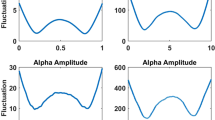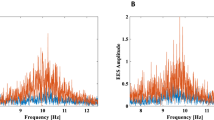Abstract
Since Berger’s discovery of the electroencephalogram (EEG), its analysis has been generally restricted to the visual range (upmost 100Hz) and has ignored higher frequency components. One reason should be that there are no reliable methods to distinguish the brain potentials from muscle activity. We have introduced fluctuation analysis, which is popular method especially in the field of basic physiology to clinical electrophysiology. In our previous study, it was declared that power spectral density (PSD) of human high frequency EEG was composed of double Lorentzians and vanished into white level within 1kHz. Then the purpose of this study is to elucidate the “Automated Fluctuation Analysis,” which enables us to evaluate these higher frequency components and its physiological meaning especially focused on conscious level from wakefulness to sleep stage 1. Seventy-four scalp recording EEGs in twenty normal subjects were studied. In short, “Automated Fluctuation Analysis” is made of three steps: amplification of EEG signal, A/D conversion and Fast Fourier Transform by signal processor and extraction of Lorentzian parameters. PSD of high frequency EEG was displayed on log-log graph and the algorithm fit to the following Lorentzian formula were mathematically based on Brown & Dennis. S(f)=S1/ [1+(f/fc1)2] + S2/ [1+(f/fc2)2], where S(f) is PSD (μ V2/Hz) at each frequency (f;Hz), S1 and S2 are the plateau level or zero-frequency power of the initial and second Lorentz, and fc1 and fc2 are the corner or half-power frequency of the initial and second Lorentz, respectively. As results, during wakefulness the PSD of high frequency EEG activity was composed of double Lorentzian fluctuations and the power distribution of S1 value in topographical display was frontal dominant. This pattern of S1 value disappeared and S2 value became lower during sleepiness and the second Lorentz disappeared during sleep.
Similar content being viewed by others
References
Brown, K.M., and Dennis, J.E. (1972). Derivative free analogues of the Levenberg Marquardt and Gauss algorithms for nonlinear least squares approximation.Numerische Mathematik, 18, 289–297.
Cull-Candy, S.G. and Ogden, D.C. (1985). Ion channels activated by L-glutamate and GABA in cultured cerebellar neurons of the rat. Proceedings of the Royal Society of London (Series B; Biological Science),224, 367–373.
Ingvar, D.H. (1979). “Hyperfrontal” distribution of the cerebral gray matter flow in resting wakefulness; on the functional anatomy of the conscious state.Acta Neurologica Scandinavica, 60, 12–25.
Kellaway, P. & Petersen, I. (1976).Automation of clinical electroencephalography. New York: Raven Press.
Kiloh, L.G., McComas, A.J., Osselton, J.W. and Upton, A.R.M. (1972).Clinical electro-encephalography. London: Butterworths.
Mori, K. (1987). The EEG and awareness during general anaesthesia.Anaesthesia, 42, 1153–1155.
Nakata, M. and Mukawa, J. (1989). Fourier analysis of broad spectral EEG from a fluctuation stand point of view.Pavlovian Journal of Biological Science, 24, 90–97.
Nakata, M., Mukawa, J., Nerome, K. & Hokama, S. (1992). Electrophysiological evaluation of human consciousness level by “Automated Fluctuation Analysis” of high frequency EEG.Brain & Nerve, 44, 1087–1093.
Rechtschaffen, A. and Kales, A. (1968). A manual of standardized terminology, techniques and scoring system for sleep stages of human subjects. Washington, D.C.: U.S. Government Printing Office, Public Health Service.
Remond, A. (1977).EEG informatics. A didactic review of methods and applications of EEG data processing. New York: Elsevier.
Tsuda, Y. & Hartmann, A. (1989). Changes in hyperfrontality of cerebral blood flow and carbon dioxide reactivity with age.Stroke, 20, 1667–1673.
Wikler, A. (1952). Pharmacologic dissociation of behavior and EEG “sleep patterns” in dogs: morphine, N-allylnormorphine, and atropine. Proceedings of the Society for Experimental Biology and Medicine,79, 261–265.
Author information
Authors and Affiliations
Rights and permissions
About this article
Cite this article
Nakata, M., Mukawa, J. & Fromm, G.H. Evaluation of human consciousness level by means of “automated fluctuation analysis” of high frequency electroencephalogram fitted by double Lorentzians. Integrative Physiological and Behavioral Science 28, 343–352 (1993). https://doi.org/10.1007/BF02690931
Issue Date:
DOI: https://doi.org/10.1007/BF02690931




